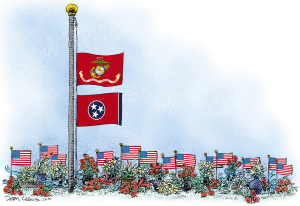
Iran and Republicans
Iraq Field GuideCorrected

Iran USA Ventriloquists

Cartoons As A Measure Of Freedom

Cartoons as a Measure of Freedom
We all know that cartoonists can get into big trouble for drawing the Prophet Muhammad, but cartoonists around the world regularly get in big trouble for drawing all kinds of things. One cartoonist in Iran is in prison for drawing a cockroach.
Mana Neyestani drew a child talking to a cockroach; in the cartoon, a boy says the word “cockroach” in different ways, and the cockroach replies, “What?” in the Azeri language of Northern Iran. Mana has a lot of Azeri friends and colleagues, a minority group that constitutes about 25 percent of Iran’s population and which is often the butt of local ethnic jokes.
It would seem that the Azeris have thin skins; when they saw Mana’s cartoon, they rioted. Thousands of Azeris filled the streets to protest the cartoon; they set fire to a newspaper office then pelted government buildings and police with stones, injuring several policemen. Dozens of rioters were arrested. Mana and his editor were abruptly fired from their jobs at “Iran Friday,” the weekend edition of one of Iran’s largest newspapers, which ran a front-page apology for three days following the riots.
Iranian officials blamed America and Israel for the riots fueled by the cartoon, but threw Mana and his editor into Tehran’s notorious Evin Prison where they face trial on charges of “insulting the Azeri minority.” Mana’s cockroach cartoon was published on May 12; the newspaper was closed down on May 23 and is awaiting a court decision on whether it may resume operations.
Tehran’s chief prosecutor, Saeed Mortazavi, is pressing the case against Mana and his editor. Mortazavi is best known for closing about 80 pro-reform newspapers in Iran and is rumored to be in line to become Iran’s next Justice Minister. He is also wanted in Canada in connection with the murder of a Canadian photo-journalist. Mortazavi ordered photographer Zahra Kazemi’s arrest and imprisonment on charges of “photographing a prison;” she died after being beaten and tortured. The Canadian Foreign Affairs Minister also accuses Mortazavi of falsifying documents to cover up his involvement in the case.
The Canadian Press quotes Prime Minister Steven Harper, “We’re appealing to the international community to use all manner of law available to detain this individual (Mortazavi), and have him face justice. I don’t know whether we’ll see a willingness or an ability to do that, but we want to make it absolutely clear that the government of Canada has not dropped this matter.” According the same Canadian Press report, Canada condemned Mortazavi’s appearance at a United Nations human rights conference this week and narrowly missed an opportunity to extradite him when he skipped a scheduled stop in Germany on his trip back to Iran.
My friend, Nik Kowsar, alerted me to Mana’s story. Nik used to be Iran’s top cartoonist; he escaped to Canada after receiving death threats. Back in Iran, Nik was recently tried and sentenced in absentia to four months in prison for insulting government officials and clerics. Nik tells me that Mana’s brother, Touka, who was another of Iran’s top cartoonists, has given up his profession out of fear.
I run a popular political cartoon web site on MSNBC.com (at www.cagle.com) where I feature Nik’s cartoons, and I used to run Touka’s work. The government of Iran recently blocked access to my site and I’ve been getting e-mails from Iranian readers, wondering where the site went and how to find it again.
Cartoons are more powerful than words. A cartoon on the editorial page screams louder than the words that surround it. The response to the Danish Muhammad cartoons shocked the West, but came as little surprise to Third World cartoonists who are used to seeing nutty reactions to their cartoons. Cartooning is a dangerous profession in much of the world where the accepted response to an insult is vengeance. The fact that a murderer is prosecuting a cartoonist should be seen as a measure of Iran’s dysfunctional society.
Most people in the West came away from the Danish Muhammad cartoon imbroglio with the idea that we need to be more tolerant of other religious views, and that drawings of Muhammad should be forbidden out of respect for the sensitivities of Muslims. Nothing could be more wrong as we see crowds riot in response to a drawing of a cockroach. The lesson to be learned from the Muhammad cartoons, from Mana, from Nik and from many other cartoonists who suffer from unreasonable Third World reactions to their cartoons, is that cartoonists are on the front lines in exposing the repression, intolerance and underlying chaos in totalitarian societies.
Daryl Cagle is a political cartoonist and blogger for MSNBC.com. He is a past president of the National Cartoonists Society and his cartoons are syndicated to more than 800 newspapers, including the paper you are reading. His books “The BIG Book of Bush Cartoons” and “The Best Political Cartoons of the Year, 2006 Edition,” are available in bookstores now.
Missile Argument
















